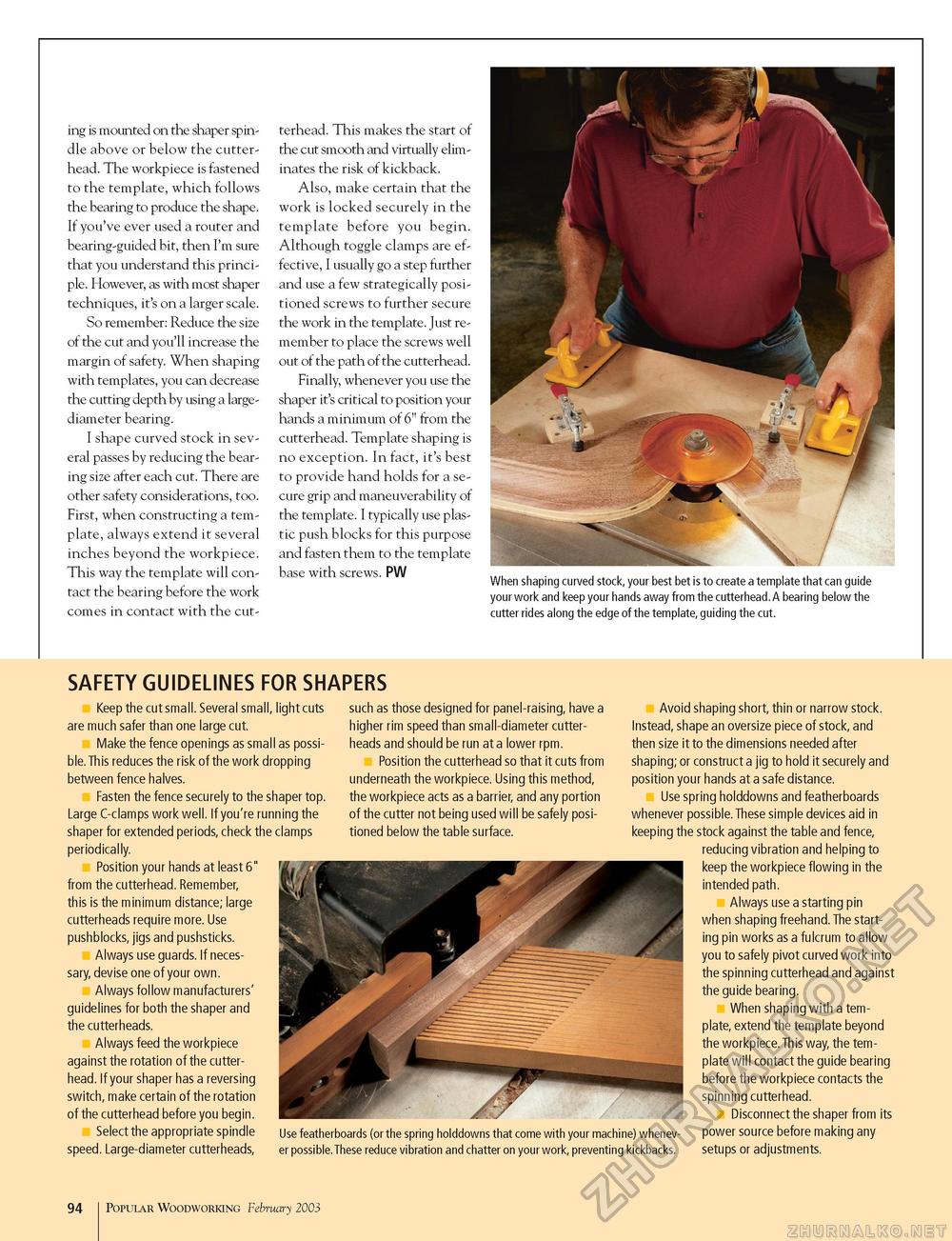Popular Woodworking 2003-02 № 132, страница 94
ing is mounted on the shaper spindle above or below the cutterhead. The workpiece is fastened to the template, which follows the bearing to produce the shape. If you've ever used a router and bearing-guided bit, then I'm sure that you understand this principle. However, as with most shaper techniques, it's on a larger scale. So remember: Reduce the size of the cut and you'll increase the margin of safety. When shaping with templates, you can decrease the cutting depth by using a large-diameter bearing. I shape curved stock in several passes by reducing the bearing size after each cut. There are other safety considerations, too. First, when constructing a template, always extend it several inches beyond the workpiece. This way the template will contact the bearing before the work comes in contact with the cut- terhead. This makes the start of the cut smooth and virtually eliminates the risk of kickback. Also, make certain that the work is locked securely in the template before you begin. Although toggle clamps are effective, I usually go a step further and use a few strategically positioned screws to further secure the work in the template. Just remember to place the screws well out of the path of the cutterhead. Finally, whenever you use the shaper it's critical to position your hands a minimum of 6" from the cutterhead. Template shaping is no exception. In fact, it's best to provide hand holds for a secure grip and maneuverability of the template. I typically use plastic push blocks for this purpose and fasten them to the template base with screws. PW When shaping curved stock, your best bet is to create a template that can guide your work and keep your hands away from the cutterhead.A bearing below the cutter rides along the edge of the template, guiding the cut. SAFETY GUIDELINES FOR SHAPERS ■ Keep the cut small. Several small, light cuts are much safer than one large cut. ■ Make the fence openings as small as possible. This reduces the risk of the work dropping between fence halves. ■ Fasten the fence securely to the shaper top. Large C-clamps work well. If you're running the shaper for extended periods, check the clamps periodically. Position your hands at least 6" from the cutterhead. Remember, this is the minimum distance; large cutterheads require more. Use pushblocks, jigs and pushsticks. ■ Always use guards. If necessary, devise one of your own. ■ Always follow manufacturers' guidelines for both the shaper and the cutterheads. ■ Always feed the workpiece against the rotation of the cutterhead. If your shaper has a reversing switch, make certain of the rotation of the cutterhead before you begin. ■ Select the appropriate spindle speed. Large-diameter cutterheads, such as those designed for panel-raising, have a higher rim speed than small-diameter cutter-heads and should be run at a lower rpm. ■ Position the cutterhead so that it cuts from underneath the workpiece. Using this method, the workpiece acts as a barrier, and any portion of the cutter not being used will be safely positioned below the table surface. Use featherboards (or the spring holddowns that come with your machine) whenever possible.These reduce vibration and chatter on your work, preventing kickbacks. ■ Avoid shaping short, thin or narrow stock. Instead, shape an oversize piece of stock, and then size it to the dimensions needed after shaping; or construct a jig to hold it securely and position your hands at a safe distance. ■ Use spring holddowns and featherboards whenever possible. These simple devices aid in keeping the stock against the table and fence, reducing vibration and helping to keep the workpiece flowing in the intended path. ■ Always use a starting pin when shaping freehand. The starting pin works as a fulcrum to allow you to safely pivot curved work into the spinning cutterhead and against the guide bearing. ■ When shaping with a template, extend the template beyond the workpiece. This way, the template will contact the guide bearing before the workpiece contacts the spinning cutterhead. ■ Disconnect the shaper from its power source before making any setups or adjustments. 94 Popular Woodworking February 2003 |








